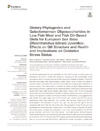Identificador persistente para citar o vincular este elemento:
https://accedacris.ulpgc.es/jspui/handle/10553/107241
| Título: | Dietary Phytogenics and Galactomannan Oligosaccharides in Low Fish Meal and Fish Oil-Based Diets for European Sea Bass (Dicentrarchus labrax) Juveniles: Effects on Gill Structure and Health and Implications on Oxidative Stress Status | Autores/as: | Torrecillas Burriel,Silvia Terova, Genciana Makol, Alex Serradell Pastor, Antonio Valdenegro Vega, Victoria Izquierdo López, María Soledad Acosta Arbelo, Félix Antonio Montero Vítores, Daniel |
Clasificación UNESCO: | 310502 Piscicultura 310406 Nutrición 251092 Acuicultura marina |
Palabras clave: | European sea bass Gill morphology Oxidative stress Functional diets Prebiotics, et al. |
Fecha de publicación: | 2021 | Proyectos: | Genomic and nutritional innovations for genetically superior farmed fish to improve efficiency in European aquaculture Dieta Funcional Para Sustitución de Ingredientes Marinos en Peces: Maximización de Resistencia A Patogenos Via Refuerzo de Barreras Epiteliales y Herramientas de Inmunización |
Publicación seriada: | Frontiers in Immunology | Resumen: | An effective replacement for fish meal (FM) and fish oil (FO) based on plant-based raw materials in the feed of marine fish species is necessary for the sustainability of the aquaculture sector. However, the use of plant-based raw materials to replace FM and FO has been associated with several negative health effects, some of which are related to oxidative stress processes that can induce functional and morphological alterations in mucosal tissues. This study aimed to evaluate the effects of dietary oligosaccharides of plant origin (5,000 ppm; galactomannan oligosaccharides, GMOS) and a phytogenic feed additive (200 ppm; garlic oil and labiatae plant extract mixture, PHYTO) on the oxidative stress status and mucosal health of the gills of juvenile European sea bass (Dicentrarchus labrax). The experimental diets, low FM and FO diets (10%FM/6%FO) were supplemented with GMOS from plant origin and PHYTO for 63 days. GMOS and PHYTO did not significantly affect feed utilization, fish growth, and survival. GMOS and PHYTO downregulated the expression of β-act, sod, gpx, cat, and gr in the gills of the fish compared with that in fish fed the control diet. The expression of hsp70 and ocln was upregulated and downregulated, respectively, in the GMOS group compared with that in the control group, whereas the expression of zo-1 was downregulated in the PHYTO group compared with that in the GMOS group. The morphological, histopathological, immunohistochemical, and biochemical parameters of the fish gills were mostly unaffected by GMOS and PHYTO. However, the PHYTO group had lower incidence of lamellar fusion than did the control group after 63 days. Although the tissular distribution of goblet cells was unaffected by GMOS and PHYTO, goblet cell size showed a decreasing trend (−11%) in the GMOS group. GMOS and PHYTO significantly reduced the concentration of PCNA+ in the epithelium of the gills. The above findings indicated that GMOS and PHYTO in low FM/FO-based diets protected the gill epithelia of D. labrax from oxidative stress by modulating the expression of oxidative enzyme-related genes and reducing the density of PCNA+ cells in the gills of the fish. | URI: | https://accedacris.ulpgc.es/handle/10553/107241 | ISSN: | 1664-3224 | DOI: | 10.3389/fimmu.2021.663106 | Fuente: | Frontiers in Immunology [ISSN 1664-3224], v. 12, 663106, (Mayo 2021) |
| Colección: | Artículos |
Citas SCOPUSTM
17
actualizado el 08-jun-2025
Citas de WEB OF SCIENCETM
Citations
13
actualizado el 30-mar-2025
Visitas 5
247
actualizado el 01-feb-2025
Descargas
198
actualizado el 01-feb-2025
Google ScholarTM
Verifica
Altmetric
Comparte
Exporta metadatos
Los elementos en ULPGC accedaCRIS están protegidos por derechos de autor con todos los derechos reservados, a menos que se indique lo contrario.
